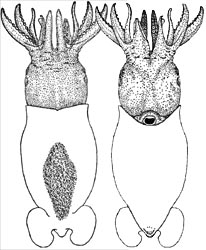Idiosepiidae
Pygmy squids
Katharina M. Mangold (1922-2003) and Richard E. Young- Idiosepius biserialis
- Idiosepius macrocheir
- Idiosepius mimus (?)
- Idiosepius notoides
- Idiosepius picteti
- Idiosepius paradoxus
- Idiosepius pygmaeus
- Idiosepius thailandicus
Introduction
This Idiosepiidae contains the smallest species within the Decapoda. Males in some species mature at lengths of 6 mm ML and females at 8 mm ML (Nesis, 1982/7). These cephalopods are elongate but have a rounded posterior mantle and separate fins. A unique attachment organ is present on the dorsal surface of the mantle which is used for attaching the animal to seaweed. They are found in shallow water in the Indo-West Pacific.
Diagnosis
A decapodiform ...
- with an adhesive organ on the dorsal surface of the mantle.
Characteristics
- Arms
- Both arms IV hectocotylized.
 image info
image info Figure. Oral view of hectocotylized arms IV of Idiosepius pygmaeus, 18 mm ML, off Philippines. Drawing from Voss (1963).
- Arms with suckers in two series.
- Arm and tentacle suckers without circularis muscles.
- Both arms IV hectocotylized.
- Tentacles
- Tentacles without carpal (= proximal) locking-apparatus.
- Tentacular clubs with suckers in 2 - 4 series.
- Head
- Head with tentacle pockets.
- Eyes with corneas.
- Funnel
- Funnel without lateral funnel adductors.
- Mantle
- Adhesive organ on dorsal surface (see title drawing).
 image info
image info  image info
image info Figure. Top - Dorsal view of Idiosepius sp., preserved, with an enlargement of a portion of the dorsal adhesive organ showing the glandular (white reflection) epithelium. 12 mm ML, mature female, 05°27'S, 134°27'E. Photograph by R. Young. Bottom -Side view of Idiosepius paradoxus in an aquarium attached by its adhesive organ to a blade of seagrass. Photograph by Takashi Kasugai, Port of Nagoya Public Aquarium.
- Mantle not fused to head in nuchal region, but nuchal cartilage absent.
- Mantle locking-apparatus does not reach anterior mantle margin.
- Adhesive organ on dorsal surface (see title drawing).
- Fins
- Fins completely separate; with posterior lobes.
- Shell
- Shell a delicate gladius not reaching anterior or posterior ends of mantle.
- Viscera
- Right oviduct present but not functional.
- Accessory nidamental glands present.
- Gills without branchial canals.
- Eggs
- Eggs attach to substrate in flat masses.
Nomenclature
A list of all nominal genera and species in the Idiosepiidae can be found here. The list includes the current status and type species of all genera, the current status, type repository and type locality of all species and all pertinent references.
Life History
I. paradoxus spawns repeatedly in captivity. A single individual may lay as many as 42 batches over a 70 day period (Kasugai, 2006). image info
image infoFigure. Side view of a spawning female I. paradoxus in an aquarium. The squid is attached to a blade of seagrass by its adhesive organ and is attaching its eggs to the underside of the same blade. Another I. paradoxus is swimming nearby, presumably a male. Photograph by Takashi Kasugai.
References
Kasugai, T. 2006. Spawning mode and reproductive output of the Japanese pygmy squid Idiosepius paradoxus (Cephalopoda: Idiosepiidae). Program and Abstract Book, CIAC '06, Hobart Tasmania.
Nesis, K. N. 1982. Abridged key to the cephalopod mollusks of the world's ocean. 385,ii pp. Light and Food Industry Publishing House, Moscow. (In Russian.). Translated into English by B. S. Levitov, ed. by L. A. Burgess (1987), Cephalopods of the world. T. F. H. Publications, Neptune City, NJ, 351pp.
Voss, G. L. 1963. Cephalopoda of the Philippine Islands. Bull. U. S. Nat. Mus., 234: 1-180.
Title Illustrations
| Scientific Name | Idiosepius notoides |
|---|---|
| Location | off Australia |
| Acknowledgements | provided by Mark Norman |
| Copyright | © 1996 David Paul |
About This Page
Katharina M. Mangold (1922-2003)
Richard E. Young
Dept of Oceanography
University of Hawaii
Honolulu, Hawaii 96822
USA
Page copyright © 1996 Katharina M. Mangold (1922-2003) and Richard E. Young
Citing this page:
Mangold (1922-2003), Katharina M. and Young, Richard E. 1996. Idiosepiidae . Pygmy squids. Version 01 January 1996 (under construction). http://tolweb.org/Idiosepiidae/19985/1996.01.01 in The Tree of Life Web Project, http://tolweb.org/








